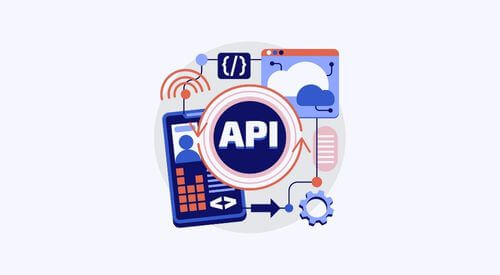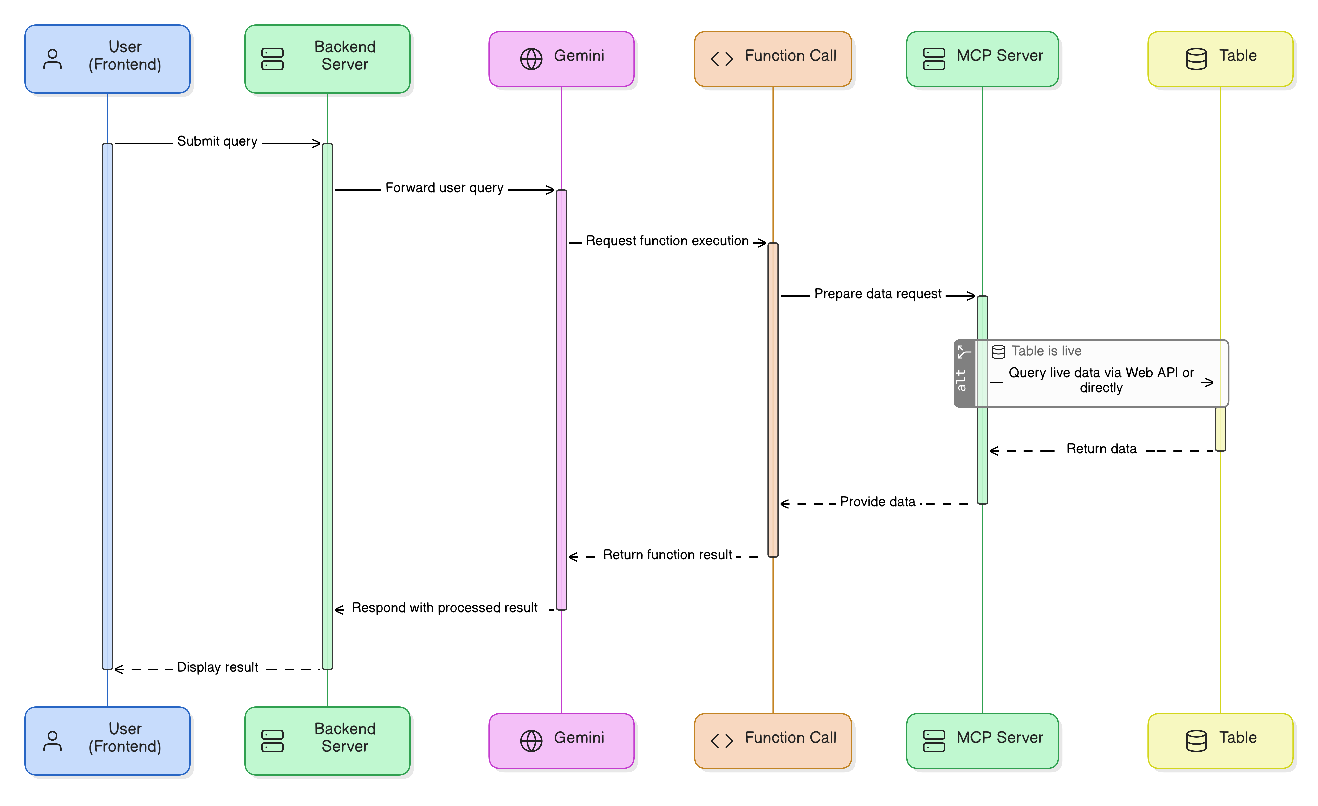

According to recent industry studies, more than 70% of insurance customers now expect real-time, AI-driven, and self-service experiences. As customer expectations evolve, insurers must modernize with intelligent tools that offer instant, personalized support. A Natural Language API interface simplifies policy queries, onboarding, and claims, enabling seamless backend routing and modernization of the insurance tech stack. This blog explores how to build and scale such AI-native insurance solutions.
Unlock insurance innovation with intelligent, real-time APIs
Reports predict that by 2026, 75% of insurance customer service interactions will be handled by AI-powered virtual agents, underlining the urgency to modernize with AI-driven solutions. To meet these rising expectations, insurers are adopting an intelligent API architecture built around four key components: Gemini Function Calling to convert natural language into actionable backend tasks, lightweight MCP Servers to securely route those tasks, a Chat UI for intuitive user engagement, smart API endpoints that connect seamlessly to policy, claims, and onboarding systems. Together, these elements enable fast, scalable, and AI-native insurance experiences.
Architecture Components and Flow
Building an intelligent insurance system requires a cohesive architecture that connects user intent to backend execution through modular, AI-powered components. According to recent surveys done, 80% of insurance executives believe that modular architecture and AI integration are key to driving future growth, while PwC notes that insurers using intelligent systems can reduce processing time by up to 50%. Here’s a breakdown of each layer in the flow:
a. Frontend: Chatbot / Conversational UI
- Serves as the primary interaction interface for users to communicate through natural language.
- Provides an easy user experience on the web or mobile.
Captures user intent with queries like:
“When does my policy expire?” or “Start a claim for my damaged bike.”
b. Gemini Function Calling
- Acts as the intelligence layer that interprets user inputs.
- Converts free-form queries into structured function calls using predefined schemas.
- Maintains conversation context, supports fallback logic, and handles session continuity.
- Supports key insurance workflows such as: Policy detail retrieval, Claim status checks, and New claim initiation
c. MCP Server: Custom API Hosting Layer
- Hosts RESTful API endpoints exposed as part of the intelligent interface layer.
- Integrates easily with monolithic backends or even dispersed microservices.
- Lightweight, adaptable, and simple to implement in contemporary cloud-native settings.
- Permits seamless communication with both modern insurance systems and legacy infrastructure.
d. Data Store (In-Memory or Persistent DB)
- Stores essential data: policy details, customer profiles, and claims records.
- Can operate in-memory for development or use persistent storage for production.
- Designed for fast access, scalability, and secure data handling across workflows.
These components work together to power intelligent insurance solutions through Natural Language API interfaces, enable automated claims processing APIs, and pave the way for complete insurance tech stack modernization using Google Cloud AI for insurance.

Figure 1: Architecture of an AI-powered insurance system using Gemini Function Calling and MCP Server.
Solving Key Business Challenges
Here’s how this intelligent architecture tackles some of the most pressing challenges faced by modern insurers:
- Interpreting free-form inputs: Gemini Function Calling powers a Natural Language API interface that transforms everyday language into structured API calls, laying the foundation to build an intelligent insurance system.
- Orchestrating fragmented microservices: The MCP Server centralizes backend orchestration, making it easier to integrate with legacy systems and modernize your insurance tech stack.
- Maintaining session continuity: Gemini’s contextual memory manages multi-turn conversations, enabling seamless experiences across the insurance digital onboarding API, claims, and more.
- Real-time and async workflows: The architecture supports both synchronous and asynchronous interactions, ideal for services like automated claims processing APIs and other customer workflows.
- Scalability for the future: With its plug-and-play modular architecture backed by Google Cloud AI for insurance, you can integrate new services effortlessly while scaling securely.
Solution Overview: Intelligent API Layer
To meet the growing demand for AI-powered, real-time, and self-service insurance experiences, this solution introduces an Intelligent API Layer purpose-built for modern insurance platforms.
Key goals of this architecture include:
- Translate user intent to structured API calls: (mainly done by NLU Engine and API Orchestration/Workflow Engine). They interpret natural language and map it to relevant backend calls. According to 2023 industry reports, organizations using NLU and orchestration layers reduce manual intervention by up to 60% and accelerate response times by 40%.
- Bridge frontend natural language interfaces with backend services: That entire layer is this bridge – something that’s responsible for hiding the complexity of different backends, showing a single intelligent interface to the frontends. According to a 2023 industry study, abstraction layers can reduce integration effort by 45% and improve time-to-market for digital experiences by up to 50%.
- Make it modular: Delivered by a microservices architecture, which means that we are not bound to anything – we can develop, deploy, and scale on our own. According to 2023 research, 69% of enterprises adopting microservices reported improved agility, and 56% cited enhanced scalability.
- Scalability : Stateless microservices (where applicable), scaling of components horizontally by Kubernetes and distributed data and message queues. According to a 2023 report, users experience a 50–60% improvement in resource utilization and deployment speed.
- Resilience: Considers resilience patterns (circuit breaker, retries, bulkheads) at the microservice level, strong error handling, API Gateway protecting the first call. A 2023 survey found that resilient architectures can reduce system downtime by up to 80%, significantly enhancing user trust and platform stability.
Key benefits of a conversational AI-powered insurance API system
- Natural Language Processing API Interface: Allows clients to communicate using common phrases. Simplifies and facilitates access to insurance services. A 2023 survey found that 69% of consumers prefer using natural language-based tools like chatbots for quick communication. Studies also show that NLP adoption in insurance can improve customer response times by up to 60% and reduce service costs by 30%.
- Automated Claims Processing API: Makes workdays easier by automating claims filing, tracking, and resolution with increased accuracy and reduced manual workflows. A 2023 study found that automation can reduce claims processing time by up to 70%, while insurers using API-driven automation have achieved up to 30% cost savings and a 25% increase in claims accuracy.
- Insurance Tech Stack Modernization: Empowers modern insurance providers to revitalize their legacy systems by transforming sophisticated backend workflows into smart APIs. This is a major step towards full insurance tech stack modernization. A 2023 industry survey found that 74% of insurers believe modernizing core systems is critical to remaining competitive. Another study shows that API-based architectures can reduce time-to-market for new insurance products by up to 40% and lower operational costs by 25%.
- Seamless Integration with Existing Systems: Achieved with fragmented microservices or monolithic backends through lightweight MCP Servers.A 2023 industry report found that 60% of insurers face integration challenges due to legacy systems. Adopting lightweight, modular architectures like MCP Servers can enable faster system connectivity and reduce integration effort by up to 45%.
- Build an Intelligent Insurance System: With Gemini Function Calling as the logic layer, intent interpretation, action routing, and session context maintenance for a seamless digital journey are done in one unified system. A 2023 industry study found that AI orchestration platforms that unify intent processing and backend execution can improve customer experience scores by up to 35% and reduce operational complexity by 40%.
How Niveus Utilises Intelligent Insurance APIs on Google Cloud
At Niveus, we bring this intelligent insurance architecture to life by combining deep expertise in Google Cloud technologies with real-world insurance domain experience. Here’s how we implement and optimize the Intelligent API Layer:
- Leveraging Google Cloud AI for Insurance: We use Gemini’s Function Calling to enable natural language understanding and convert user inputs into precise backend actions, powering everything from policy inquiries to claims processing.
- Deploying Scalable MCP Servers: Our engineers design lightweight, cloud-native MCP servers that securely route function calls and interact with existing insurance microservices or legacy systems.
- Building Seamless Chat Interfaces: Niveus integrates intuitive Chat UIs across web and mobile channels to provide real-time, conversational customer experiences.
- Connecting the Dots with Smart API Endpoints: Whether it’s an automated claims processing API or an insurance digital onboarding API, we ensure smooth and secure integration with your core systems, without the need to rebuild from scratch.
- Driving Insurance Tech Stack Modernization: We help insurers modernize their tech stack by using a modular, AI-driven approach that makes it faster, smarter, and more customer-focused.
Get Started with Intelligent Insurance APIs on Google Cloud
Start modernizing your insurance tech stack today by leveraging Google Cloud AI, Natural Language API interfaces, and intelligent solutions like automated claims processing and digital onboarding APIs.
- Assess Needs: Begin by examining the established systems and where they might fall short in UX, backend scalability, and API integrations. Concentrate on where value can be delivered using real time, AI driven services and natural language interfaces.
- Choose the Right Partner: When you work with an expert in the cloud like Niveus Solutions, you can ensure a smooth shift to smart APIs. Leveraging extensive experience in Google Cloud AI for insurance, we enable you to build, deploy and scale intelligent digital ecosystems.
- Strategies to Implement: Create a clear road-map with clear milestones, resource planning, risk assessment that would help you minimize your exposure. Start small with pilot APIs (e.g. claims or onboarding) and make sure that your data is ready before you scale and extend your use cases.
- Implement and Optimize: Appeal in stages and track performance, refining as you proceed. Take Advantage of Feedback Loops, Analytics, and Automation for Quicker Responses, Accuracy, and Experience Next Time around.
Conclusion
Together, Gemini Function Calling and the MCP Server enable insurers to build an intelligent insurance system that connects natural language input with backend precision. By using a natural language API interface, insurers can deliver faster response times, boost self-service adoption, and implement a scalable, maintainable API layer powered by automated claims processing APIs and insurance digital onboarding APIs. In fact, a 2023 industry report indicates that AI can automate up to 50% of current insurance claims processes, while insurers leveraging AI-driven customer interactions have seen a 20–30% increase in self-service adoption. Now is the time to embrace Google Cloud AI for insurance, modernize your insurance tech stack, and embed AI agents that shape the future of digital insurance.











